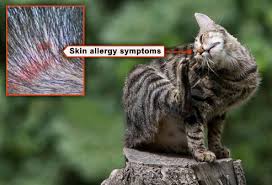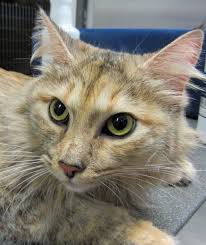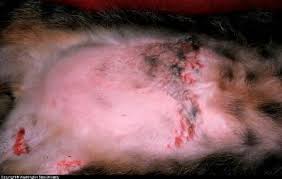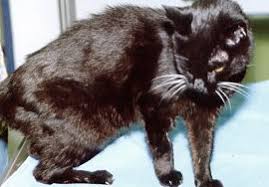Causes & Treatments of Hair Loss in Cats
 There are different causes of hair loss in
cats, some are quite normal, while others can indicate an illness that requires
medical attention. Excessive hair loss in cats is also known as "Alopecia".
Alopecia is not a disease, but a
symptom. Cats normally shed more hair during warm spring and early summer
months.
There are different causes of hair loss in
cats, some are quite normal, while others can indicate an illness that requires
medical attention. Excessive hair loss in cats is also known as "Alopecia".
Alopecia is not a disease, but a
symptom. Cats normally shed more hair during warm spring and early summer
months.
Most Common Causes of Cat Hair
Loss
Flea Allergy Dermatitis
 Cats may experience flea bite
hypersensitivity, which is caused by an intensive reaction to the saliva of the
flea. They will go to any lengths to reach the agitated skin, including biting
off hair in the bothersome areas. Common symptoms include extreme itching,
redness, scaling, and hair loss. In some cases, the infected area can become
infected, which will require more intensive treatment.
Cats may experience flea bite
hypersensitivity, which is caused by an intensive reaction to the saliva of the
flea. They will go to any lengths to reach the agitated skin, including biting
off hair in the bothersome areas. Common symptoms include extreme itching,
redness, scaling, and hair loss. In some cases, the infected area can become
infected, which will require more intensive treatment.
Atopy
 Some cats are also allergic to pollens and
allergens like dust, mold, smoke. This causes redness and itching around the
ears and feet. The cat will excessively lick and bite the skin which eventually
leads to hair loss. Initial treatment includes reducing the exposure to the
allergen, steroids, anti-histamines and special shampoos.
Some cats are also allergic to pollens and
allergens like dust, mold, smoke. This causes redness and itching around the
ears and feet. The cat will excessively lick and bite the skin which eventually
leads to hair loss. Initial treatment includes reducing the exposure to the
allergen, steroids, anti-histamines and special shampoos.
Atopic Dermatitis
Poor Nutrition
 Hair loss due to poor nutrition often affects
the whole cat, although it may affect areas that are easily worn and over the
back and hips where hair follicles have shorter growth cycles and longer
inactive periods.
Hair loss due to poor nutrition often affects
the whole cat, although it may affect areas that are easily worn and over the
back and hips where hair follicles have shorter growth cycles and longer
inactive periods.
It is important that your
cat food contain nutrients that support healthy hair and skin, such as:
vitamins, minerals, antioxidants, Omega 3 and Omega 6 fatty acids.
Food Allergy Dermatitis
 Another cause of cat hair loss is food
allergy. Common food allergies are caused by grains (wheat, corn, soy), meats
and fish (beef, lamb, pork, salmon), milk and yeast. In addition to hair loss,
cats may also show other symptoms such as: reddened ears, excessive licking on
the feet, itching and blistering and infection in certain areas. By feeding
your cats with nutritious and balanced diet they will live a long and healthy
life.
Another cause of cat hair loss is food
allergy. Common food allergies are caused by grains (wheat, corn, soy), meats
and fish (beef, lamb, pork, salmon), milk and yeast. In addition to hair loss,
cats may also show other symptoms such as: reddened ears, excessive licking on
the feet, itching and blistering and infection in certain areas. By feeding
your cats with nutritious and balanced diet they will live a long and healthy
life.
Hyperthyroidism
 Hyperthyroidism is the most common hormonal
disorder that cats experience, which will cause hair loss, weight loss, and
skin lesions. This disorder is diagnosed with a blood thyroid level check, and
it can be easily controlled with medication or radioactive iodine therapy.
Hyperthyroidism is the most common hormonal
disorder that cats experience, which will cause hair loss, weight loss, and
skin lesions. This disorder is diagnosed with a blood thyroid level check, and
it can be easily controlled with medication or radioactive iodine therapy.
Ringworm

A fungal infection. Scaly, crusty, or red
circular patches 1⁄2 to 2 inches (12 to 50 mm) across. Patches show central
hair loss with a red ring at the periphery. Sometimes just broken hairs around
the face and ears. May become infected. Highly contagious, including to humans.
Psychogenic Dermatitis
 Psychogenic dermatitis, also called feline
psychogenic alopecia, occurs when a cat licks himself excessively, due to
anxiety, stress, fear, or boredom. The excessive liking can cause cat hair
loss, skin irritation, and open sores.
Psychogenic dermatitis, also called feline
psychogenic alopecia, occurs when a cat licks himself excessively, due to
anxiety, stress, fear, or boredom. The excessive liking can cause cat hair
loss, skin irritation, and open sores.
Diagnosis of cat hair loss
- Fungus culture - To look for ringworm.
- Specific blood tests - To check for
hyperthyroidism.
- Specific blood tests - To check for Cushing's
disease.
- Skin scrapings - To study under a microscope
to look for mites.

No comments:
Post a Comment